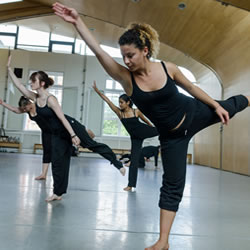
I wondered why teaching like this worked (and still wondered why people didn’t laugh). Perhaps using movement instead of words was a gentler way of presenting information which ordinarily made people anxious – you only have to mention the word 'statistics' to undergraduate psychology students and you can see the fear creep onto their faces and notice them go slightly pale. I wanted to challenge this, so after discussing with a colleague at the British Psychological Society annual conference in 2011, I decided to make some films which explained psychological statistics using dance. To my delight, the British Psychological Society liked the idea and encouraged me to apply for a Public Engagement Grant which I was successful in.
As I’m sure many readers know, this idea isn’t new – the annual ‘Dance your PhD’ competition asks doctoral students to dance their theses and there have been numerous TED talks which focus on this too (try Jon Bohannon’s TED talk ‘Dance vs. PowerPoint: A Modest Proposal’). Dr Peter Lovatt, AKA ‘Dr Dance’ runs a dance lab at Hertfordshire University where he does research into how people feel when they dance and watch dancing and he looks at ‘embodied learning’. I started thinking about others who might be interested in quirky ways of teaching statistics and Professor Andy Field’s name sprang to mind. Anyone familiar with his work will know that he makes stats funny, interesting and most importantly, understandable. He liked the idea (eventually) and came on board too, though it took a bit of persuasion.
I was introduced to Elise Phillips who works at Laban Dance School but who is also a project manager. She was able to find a great group of dancers, recruit our choreographer and filmmaker, and found the location for filming (Siobhan Davies Dance Studio). After a number of sessions in the studio where we worked on exactly how we were going to communicate these concepts via dance, our choreographer Masha Gurina expertly communicated the admittedly complicated and sometimes seemingly impossible ideas to the dancers who translated them beautifully. Kyle Stevenson, our filmmaker, suggested feasible ways to bring the ideas to life and kept our feet on the ground when our ideas ran away with us.
The aim was to create a way to reduce the fear of statistics for students and create some aids to use alongside their research methods courses – I wish to make it clear that these are not instead of lectures! Lecturers have been using the films in their classes internationally and some research into their efficacy is planned for this year. To my delight educators from a wide-range of disciplines and levels of study have showed the films to their students who have found them useful. Additionally over 50 articles and blogs have been published online and the story has been tweeted by organisations such as the Times Higher Education Supplement, Nuffield Foundation, the Higher Education Academy, the Mathematical Association of America and Statistics2013.org (check out the ‘Favourited’ Tweets @statsdancer’s account for more of an idea of impact). The films have also featured on a number of websites that help teach maths and numeracy more generally (Sophia.org and Mathstutor.ac.uk to name just two).
There are some stats we didn’t have time to cover so I will be seeking funding in order to do similar projects in the future, and some of the feedback I’ve received about the films has given an indication of what people want.
Most don’t ordinarily associate statistics with dance but as many will know, it’s often the more unusual and surprising ideas that are the most memorable. The hope is that the films enable students to see that actually, when you step away from the algebra, just for a moment, statistics can be quite beautiful and not scary at all.
The ‘Correlation’ film has been the most popular, however, this was actually the last one we filmed and the one that we worked on the least. I think this is to do with the fact it’s first on the list (an order effect perhaps), however it’s actually my least favourite film. It had originally been intended to be a ‘regression’ dance, though this wasn’t translating particularly well so we decided to do correlation instead. The negative correlation demonstration doesn’t effectively demonstrate the relationship as well as the others in my opinion. My favourite film is the ‘Sampling and Standard Error’ one as it conveys the concepts pretty well and gets a lot across in a short space of time. The ‘Frequency Distribution’ and ‘Variance’ films also work very well, though all are receiving positive feedback and comments on YouTube.
You can find the films below and join the conversation on by following me on Twitter.
Explaining the statistical concept of sampling and standard error
Explaining the statistical concept of variance
Explaining the statistical concept of frequency distributions
Explaining the statistical concept of correlation
Photography courtesy of Jonathon Vines.




